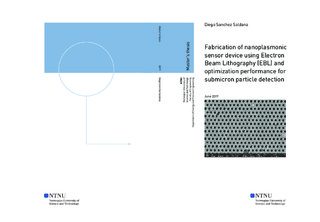| dc.description.abstract | The detection of nanosized particles is playing a main role in the field of protecting the environment and public health nowadays. Online monitoring is necessary to control pollutants in our environment, due to legislation regulations and the development of new technologies. Environmental monitoring has raised several issues, including the control of CO2 levels, drinking water quality, and the detection of specific components in waste. Moreover, related to the medical field, the detection of target particles in fluids, such as exosomes in blood which can lead to an early detection of cancer. Exiting methods, such as gas/liquid chromatography-mass spectrometry, inductively coupled plasma mass spectroscopy, and analytical centrifugation, can already perform this detection. These methods, however, require elaborate sample preparation and are costly. One alternative presented in literature is the use of plasmonic nanostructures as a promising sensor device.
The main goal of this work is to optimize a gold nanostructured mesh sensor for surface plasmon resonance (SPR) by testing different geometries and thicknesses of gold deposited, as well as a performance study of different substrates, implementation of microfluidics, surface acoustic waves (SAW) and functionalization of the sensor. The fabrication method is based on Electron Beam Lithography (EBL) combined with electron beam evaporation for thin-film metal deposition, less costly than methods currently provided in the literature. Microfluidics are developed with soft lithography. SAW is made with photolithography and functionalization is carried out with Polyethylene Glycol (PEG). This study developed a Lab-on-a-chip prototype including nanoplasmonic sensor for detection, SAW for mixing optimization improving detection and functionalization for achieving binding effects of target particles together with microfluidic implementation, reducing liquid sample usage.
This work demonstrates use of the nanofabrication method of a device with controllable gold patterned structures to enhance the optical characteristics, use as nanoplasmonic sensors combined with microfluidics, SAW and gold surface functionalization for nanosized particle detection.
Key words – nanoparticles detection, plasmonic sensors, nanofabrication, Electron Beam Lithography, microfluidics, SAW, functionalization. | |
